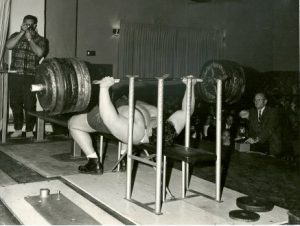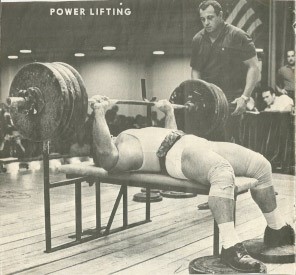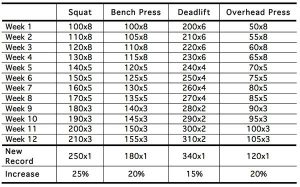By Marty Gallagher
No-tension, Paused, Dumbbell Flat Bench Press
Key Technical Points
- Sit on an exercise bench with two dumbbells pulled tight to torso.
- Lay back while simultaneously rotating bells outward into start position.
- Allow the muscles of torso and arms to relax.
- Bells will stretch chest and delt muscles downward in “pre-stretch.”
- Slowly and with control push bells upward and inward, touch bells at top.
- Lock elbows completely.
- When lowering bells, pull downward with tension in arms and flexed lats.
- Relax at bottom of rep, let bells stretch chest and shoulder muscles.
- Stay relaxed in the neck and upper traps/levator scapulae.
- Pause at the turnaround, where descent becomes ascent.
- Push upward slow and smooth in non-explosive fashion.
- Push is purposefully difficult making light poundage feel heavy.
Regular Paused Dumbbell Bench Press
Key Technical Points
- Get the bells into starting position and press them to arms length.
- Push upward and inward in reverse V push: up and in, never outward.
- Lock the elbows at completion of 1st rep.
- Lower with tension, pull the bells down; do not lower them on limp arms.
- Inhale on the descent using diaphragm breathing.
- Pull the bells down to the highest part of the chest.
- Do not release tension.
- Pause and push to arms length, exhale using diaphragm exhalation.
- Lower with tension, pause with tension, explode with tension.
Touch-and-Go Dumbbell Bench Press
Key Technical Points
- Follow all the technical rules of the paused dumbbell bench press.
- No pause at the bottom turnaround.
- Do not bounce the dumbbells.
- Smooth transitions from descent to ascent.
- Complete elbow lockout.
- Touch and go dumbbell benching allows for “over-load.”
Paused Barbell Bench Press: Three Grip Widths

Irish Mel Hennessy presses 545 weighing 215 in 1967. Huge Cassidy and I watched Mel make this lift and a subsequent 585 using this flat-as-a-pancake, all power style. Back then competitive bench presses were done with a TWO SECOND pause: referee would count, “one thousand and one, one thousand and two – PRESS!” This ‘make it harder’ mentality has been replaced with ‘make it easier mentality.’ Note street shoes. This type of power is built taking small, sequential steps.
Key Technical Points
- Lie back on a bench; take a slightly wider then shoulder width grip.
- This is your neutral/normal grip.
- Eyes are underneath the barbell.
- Exhale and simultaneously push upward, breaking bar from supports.
- Lower with tension.
- Synchronize lowering with diaphragm inhalation.
- Do not allow elbows to flare out, “tuck them inward” as you lower.
- Lower down to the high point of the inhaled chest.
- Push upward in a precise arc: bar starts and ends over the eyes.
- Standard or neutral grip width is used for 60% of bench press training time.
- Wide and narrow grip barbell bench grips are each used 20% of the time.
- Wide-grip bench press: go out one fist-width wider than standard grip.
- Narrow grip: one fist-width narrower than neutral/normal grip.
- Wide-grip builds starting power and these are paused.
- Narrow-grip builds finish power and are done ‘touch and go’ style.
Touch-and-Go Barbell Bench Press

Irish Pat Casey (lots of Irish power-men back in the day, including Cassidy and Gallagher) hits a 575 opening bench press attempt. Pat went on this day to blast up 615. Casey took this ponderous poundage out of the racks by himself and replaced the bar onto the tiny, supports without spotters. Again, these were bench presses done with 2-second pauses. Back in primordial days of yore, men sought ways to make lifts more difficult: nowadays men seek ways to make lifts easier. We resurrect this ancient philosophy of making resistance training hard – ponder the irresolvable contradiction of making resistance training easier.
Key Technical Points
- Follow all the technical rules of the paused barbell bench press.
- No pause at the bottom turnaround.
- Do not bounce the barbell off the chest.
- Smooth transition from descent to ascent.
- Hard lockout, flexed elbows.
- Touch-and-go allows for muscular “over-load.”
- Overload technique promotes and instills explosiveness
- Overload is only allowed after previous phases are mastered
How to Periodize
In the world of strength training the use of periodization is standard operating procedure and should become an integral part of your training. Periodization is another word for preplanning. Elite strength athletes will lay out 3-4 months of preplanned workouts ahead of time; identifying target poundage, number of sets and reps for each and every workout.
Hall of Fame lifter (and current world record holder) Kirk Karwoski and I would lay out his periodized training template twice a year: before the national championships and world championships. For the last few years of his career he was able to complete an entire 12-week periodized game plan without missing a single preplanned set, rep and poundage target. Other greats such as Ed Coan and Doug Furnas were equally adept.

Kirk Karwoski squats 1003 pounds at the 1995 Nationals.
Here is how an individual with a 200 pound squat, a 150 pound bench press, a 300 pound deadlift and a 100 pound overhead press might lay out a 12 week periodized game plan. Each set and rep combination is performed after taking as many warm-up sets as needed.
This template can be modified and utilized regardless current strength levels.

Key Points
- All lifts start off at approximately 50% to 65% of current max
- All lifts end up roughly 15% to 25% above current max
- All lifts utilize pristine technique
- Optional: In early phases, multiple top sets can be used
- Never start off too high or too low
Creating Your Own
Periodized Training Template
In a nutshell, the way to periodize or “cycle” any lift is as follows….
- Create a realistic goal
- Establish a realistic timeframe
- Reverse engineer: work backwards with a calendar, pen and legal pad
- Place the realist goals within a specified timeframe
- Work backwards to establish weekly poundage benchmarks
- Every 3-4 weeks alter the variables in anticipation of stagnation
- When instituting changes, make them dramatic, not minor
Scenario: let us assume a 195 pound individual is athletic, but slightly out-of-shape coming off the winter holidays; he wants to take ten weeks to lean out and shape up. His previous deadlift best was 390×1 and his leanest, most athletic and functional bodyweight in the past has been 185-188 pounds.
In ten weeks time our hypothetical individual has morphed from a soft 195 into a rock hard 180 pounds. His deadlift, a great overall strength indicator, has leapt upward by a full 10%, from 390 for 1 rep to 435 for 1. He has regained his cardio condition by tweaking his run durations and weekly frequencies. In 70 days he has gotten himself into prime fighting condition. This is a fairly conservative example and mirrors what I do with clients and students every single week.
